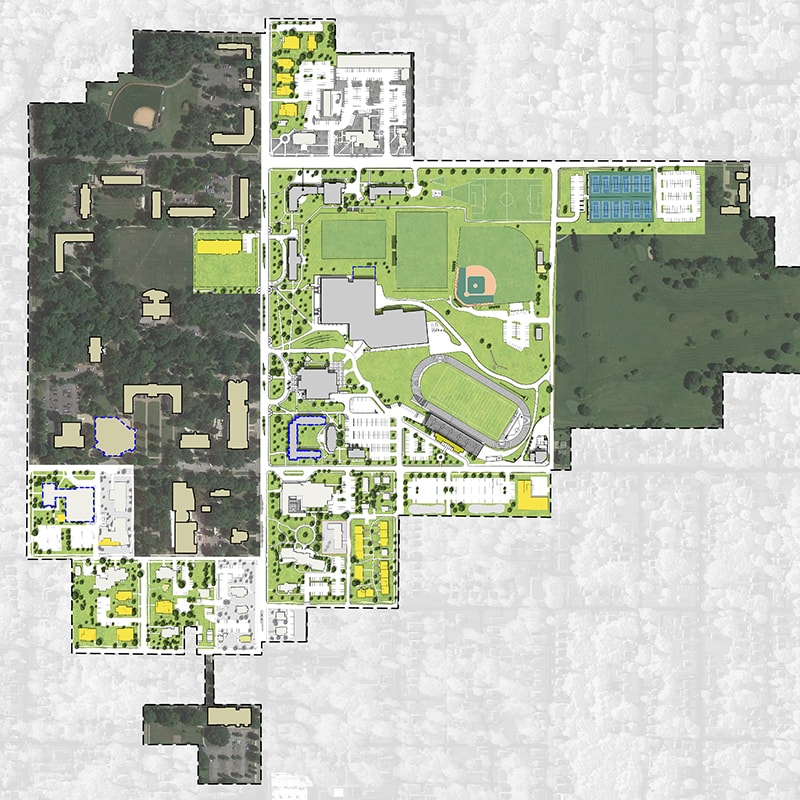The Landscape of Post-Pandemic Master Planning, Part I

Wednesday, March 31, 2021
Since higher education has survived a year under the pressure and challenges brought about by the COVID-19 pandemic, our experts have been looking ahead to how these changes will affect campus master planning going forward. Naturally, some changes will forever alter the landscape of higher education, however, other adaptations to the conditions of the pandemic will gradually be phased out. Campus master plans are important tools used to analyze a college’s context, its framework and its brand in order to develop a plan for growth and change for the next 10 to 20 years. Planning is influenced by a multitude of factors and stakeholders, including current facilities conditions, current and project enrollment, and existing curriculum and desired future curriculum delivery methodology.
While no one can predict the future with total certainty, our extensive campus master planning experience on 60+ collegiate campuses coupled with our national perspective offers some insight into where master planning may be headed. Certainly, turning a vision into an actionable plan has become more complex with advances in education, technology, and more. However, with increased complexity comes greater opportunity to engage a campus community through virtual visioning sessions and town hall meetings. We asked our campus master planning experts for their thoughts on what the post-pandemic master plan should consider, and this is what they said.
- Space demands are continually evolving. The events of the past year have shifted the paradigm of where and how we live and work. As a result, our experts anticipate increased demand for collaboration spaces where faculty and students can meet and learn together. While some students may have benefitted greatly from the flexibility of online learning, others may crave in-person learning environments even more to enhance learning or overcome learning challenges. There may be more interest in hoteling or office sharing as virtual instruction and meetings become even more commonplace in the coming years. As campuses rebound from the financial impact of the pandemic and enrollment of traditional students declines in the mid-2020s, expansions and substantial renovations might become more commonplace as institutions seek to optimize their existing facilities instead of investing in new construction. Managing existing space well will be a key differentiator for institutions that attract and retain students to their thriving campus community. Master planning at successful colleges and universities will always feature facility goals, though post-pandemic plans should be particularly attentive to simultaneously providing enough guidance to physically manifest the institution’s vision and remaining flexible enough to keep up with changing space demands. President Emeritus of Centre College, John Roush, comments that campus master planners “must acknowledge the changing landscape and give colleges and universities the flexibility they will need with their facilities, whether it is current or projected construction or renovation.”
- Quality infrastructure and technology will be a key differentiator. As brought to the forefront due to COVID-19, maintaining optimal indoor air quality will be important for institutions seeking to reassure faculty, staff, students and their families of the healthiness of their facilities. Campus networks will become more robust and secure to accommodate increased virtual reliance and ward off cyberthreats. Forward-thinking campuses will consider expanded environments for synchronous and asynchronous learning to facilitate evolving pedagogies that best benefit student learning. Investments in enhanced scheduling and reporting systems to manage space needs will likely become more common as campuses seek to more efficiently manage and optimize their existing resources. Additionally, student communication systems and apps can serve as more to help manage health, wellness, and communication between an institution and its student population. Responding to the insights gained from new communication systems and apps may prove to be an important tool in proving an institutions’ accountability to students. The planning and implementation of campus master plans will certainly become more reliant on new and emerging technologies to manage data, streamline communication, and increase transparency.
- Institutional accountability is more important than ever. There is no question that the value of education has been scrutinized due to mounting student debt and the switch to online education on many campuses. Hastings+Chivetta’s Planner and Programmer Nancy Sopuch asserts that “there is a growing interest in accountability regulation which may require institutions to phase out programs of low value with poor prospects for jobs and income.” Currently, the College Scorecard is one government-sponsored website that students and families can use to review an institutions’ programs, performance, cost, and income potential following graduation. Resources such as this help foster transparency and are proactive about keeping colleges and universities accountable to their students and their best interests. Additionally, there has been some legislation introduced like the College Transparency Act which requires the National Center for Education Statistics (NCES) to set up a tracking system to correlate student performance, debt, and career/income after college. Future accountability legislation may force colleges and universities to consider how to repurpose space formerly used for low-value programs in their campus master plans.
Our experts look forward to adding to and enhancing these insights as our perspectives grow and evolve as we know more about the lasting effects of the pandemic on higher education. The second part to these insights into master planning, “The Landscape of Post-Pandemic Master Planning, Part II” will be released mid-October.